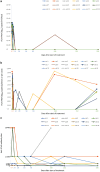Long-term follow-up of cats in complete remission after treatment of feline infectious peritonitis with oral GS-441524
- PMID: 37548535
- PMCID: PMC10811998
- DOI: 10.1177/1098612X231183250
Long-term follow-up of cats in complete remission after treatment of feline infectious peritonitis with oral GS-441524
Abstract
Objectives: Feline infectious peritonitis (FIP), a common disease in cats caused by feline coronavirus (FCoV), is usually fatal once clinical signs appear. Successful treatment of FIP with oral GS-441524 for 84 days was demonstrated recently by this research group. The aim of this study was to evaluate the long-term outcome in these cats.
Methods: A total of 18 successfully treated cats were followed for up to 1 year after treatment initiation (9 months after completion of the antiviral treatment). Follow-up examinations were performed at 12-week intervals, including physical examination, haematology, serum biochemistry, abdominal and thoracic ultrasound, FCoV ribonucleic acid (RNA) loads in blood and faeces by reverse transciptase-quantitative PCR and anti-FCoV antibody titres by indirect immunofluorescence assay.
Results: Follow-up data were available from 18 cats in week 24, from 15 cats in week 36 and from 14 cats in week 48 (after the start of treatment), respectively. Laboratory parameters remained stable after the end of the treatment, with undetectable blood viral loads (in all but one cat on one occasion). Recurrence of faecal FCoV shedding was detected in five cats. In four cats, an intermediate short-term rise in anti-FCoV antibody titres was detected. In total, 12 cats showed abdominal lymphadenomegaly during the follow-up period; four of them continuously during the treatment and follow-up period. Two cats developed mild neurological signs, compatible with feline hyperaesthesia syndrome, in weeks 36 and 48, respectively; however, FCoV RNA remained undetectable in blood and faeces, and no increase in anti-FCoV antibody titres was observed in these two cats, and the signs resolved.
Conclusions and relevance: Treatment with GS-441524 proved to be effective against FIP in both the short term as well as the long term, with no confirmed relapse during the 1-year follow-up period. Whether delayed neurological signs could be a long-term adverse effect of the treatment or associated with a 'long FIP syndrome' needs to be further evaluated.
Keywords: FIP; Feline coronavirus FCoV; GS-441524; antiviral chemotherapy; long-term observation; nucleoside analogue; survival; therapy.
Conflict of interest statement
The authors declared no potential conflicts of interest with respect to the research, authorship, and/or publication of this article.
Figures


References
-
- Addie DD, Toth S, Murray GD, et al.. Risk of feline infectious peritonitis in cats naturally infected with feline coronavirus. Am J Vet Res 1995; 56: 429–434. - PubMed
MeSH terms
Substances
LinkOut - more resources
Full Text Sources
Miscellaneous

